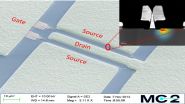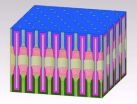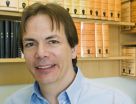Noise in a microwave amplifier is limited by quantum particles of heat
2014-11-10
(Press-News.org) As part of an international collaboration, scientists at Chalmers University of Technology have demonstrated how noise in a microwave amplifier is limited by self-heating at very low temperatures. The results will be published in the prestigious journal Nature Materials. The findings can be of importance for future discoveries in many areas of science such as quantum computers and radio astronomy.
Many significant discoveries in physics and astronomy are dependent upon registering a barely detectable electrical signal in the microwave regime. A famous example of this was the discovery of cosmic background radiation that helped confirm the Big Bang theory. Another example is the detection of data from scientific instruments in space missions on their way to distant planets, asteroids or comets.
Faint microwave signals are detected by transistor-based low-noise amplifiers. Researchers at Chalmers University of Technology have now optimised indium phosphide transistors using a special process for this purpose. A spin-off company from Chalmers, Low Noise Factory, designs and packages amplifier circuits.
"Cooling the amplifier modules to -260 degrees Celsius enables them to operate with the highest signal-to-noise ratio possible today," says Jan Grahn, Professor of microwave technology at Chalmers. "These advanced cryogenic amplifiers are of tremendous significance for signal detection in many areas of science, ranging from quantum computers to radio astronomy."
Using a combination of measurements and simulations, the researchers investigated what happens when a microwave transistor is cooled to one tenth of a degree above absolute zero (-273 degrees Celsius). It was thought that noise in the transistor was limited by so-called hot electrons at such extreme temperatures. However, the new study shows that the noise is actually limited by self-heating in the transistor.
Self-heating is associated with phonon radiation in the transistor at very low temperatures. Phonons are quantum particles that describe the thermal conductivity of a material. The results of the study are based on experimental noise measurements and simulations of phonons and electrons in the semiconductor transistor at low temperatures.
"The study is important for the fundamental understanding of how a transistor operates close to absolute zero temperature, and also how we should design even more sensitive low-noise amplifiers for future detectors in physics and astronomy," explains Jan Grahn.
INFORMATION:
The research has been performed as part of an international exchange between Chalmers University of Technology in Sweden and the California Institute of Technology. Co-authors are the University of Salamanca and the Swedish company Low Noise Factory. The study was conducted at the Gigahertz Centre, a joint venture between Chalmers, research institutes, company partners and the Swedish Governmental Agency for Innovation Systems (Vinnova).
[Attachments] See images for this press release:


ELSE PRESS RELEASES FROM THIS DATE:
2014-11-10
This news release is available in French. The motor neurons that innervate muscle fibres are essential for motor activity. Their degeneration in many diseases causes paralysis and often death among patients. Researchers at the Institute for Stem Cell Therapy and Exploration of Monogenic Diseases (I-Stem - Inserm/AFM/UEVE), in collaboration with CNRS and Paris Descartes University, have recently developed a new approach to better control the differentiation of human pluripotent stem cells, and thus produce different populations of motor neurons from these cells in only ...
2014-11-10
AUSTIN, Texas -- Researchers at the Cockrell School of Engineering at The University of Texas at Austin have achieved a milestone in modern wireless and cellular telecommunications, creating a radically smaller, more efficient radio wave circulator that could be used in cellphones and other wireless devices, as reported in the latest issue of Nature Physics.
The new circulator has the potential to double the useful bandwidth in wireless communications by enabling full-duplex functionality, meaning devices can transmit and receive signals on the same frequency band at ...
2014-11-10
Researchers from the Norwegian University of Science and Technology (NTNU) and the University of Cambridge in the UK have demonstrated that it is possible to directly generate an electric current in a magnetic material by rotating its magnetization.
The findings reveal a novel link between magnetism and electricity, and may have applications in electronics.
The electric current generation demonstrated by the researchers is called charge pumping. Charge pumping provides a source of very high frequency alternating electric currents, and its magnitude and external magnetic ...
2014-11-10
LA JOLLA, CA--November 10, 2014--Chemists at The Scripps Research Institute (TSRI) and the Shanghai Institute of Organic Chemistry have described a method for creating and modifying organic compounds that overcomes a major limitation of previous methods. The advance opens up a large number of novel chemical structures for synthesis and evaluation, for example, as candidate pharmaceuticals.
The new method was designed to avoid an unwanted side effect--a diversion of a catalyst molecule to the wrong location--that prevents chemists from manipulating many organic compounds ...
2014-11-10
The Southern Ocean plays an important role in the exchange of carbon dioxide between the atmosphere and the ocean. One aspect of this is the growth of phytoplankton, which acts as a natural sponge for carbon dioxide, drawing the troublesome greenhouse gas from the atmosphere into the sea. When these plankton die they can sink to the bottom of the ocean and store some of the carbon dioxide they have absorbed, a process scientists call the "biological carbon pump".
Although many areas of the Southern Ocean are rich in nutrients, they often lack iron, which limits phytoplankton ...
2014-11-10
Cold Spring Harbor, NY - Think about all the things you are doing at this moment. As your eyes scan across the lines of this article, maybe your brain is processing the smell of coffee brewing down the hall and the sound of leaf blowers outside your window. Maybe you are tapping your foot and spinning a pen between your fingers. At any given moment, your brain is simultaneously processing a multitude of information from your senses while supporting a dizzying array of behaviors.
How is all this information processed at once? The provisional answer, for decades, has centered ...
2014-11-10
COLLEGE PARK, Md. -- Researchers at the University of Maryland have invented a single tiny structure that includes all the components of a battery that they say could bring about the ultimate miniaturization of energy storage components.
The structure is called a nanopore: a tiny hole in a ceramic sheet that holds electrolyte to carry the electrical charge between nanotube electrodes at either end. The existing device is a test, but the bitsy battery performs well. First author Chanyuan Liu, a graduate student in materials science & engineering, says that it can be ...
2014-11-10
OAK RIDGE, Tenn., Nov. 10, 2014--For more than 50 years, scientists have debated what turns particular oxide insulators, in which electrons barely move, into metals, in which electrons flow freely. Some scientists sided with Nobel Prize-winning physicist Nevill Mott in thinking direct interactions between electrons were the key. Others believed, as did physicist Rudolf Peierls, that atomic vibrations and distortions trumped all. Now, a team led by the Department of Energy's Oak Ridge National Laboratory has made an important advancement in understanding a classic transition-metal ...
2014-11-10
Cold Spring Harbor, NY - There are roughly 20,000 genes and thousands of other regulatory "elements" stored within the three billion letters of the human genome. Genes encode information that is used to create proteins, while other genomic elements help regulate the activation of genes, among other tasks. Somehow all of this coded information within our DNA needs to be read by complex molecular machinery and transcribed into messages that can be used by our cells.
Usually, reading a gene is thought to be a lot like reading a sentence. The reading machinery is guided ...
2014-11-10
Thousands of never-before-seen genetic variants in the human genome have been uncovered using a new genome sequencing technology. These discoveries close many human genome mapping gaps that have long resisted sequencing.
The technique, called single-molecule, real-time DNA sequencing (SMRT), may now make it possible for researchers to identify potential genetic mutations behind many conditions whose genetic causes have long eluded scientists, said Evan Eichler, professor of genome sciences at the University of Washington, who led the team that conducted the study.
"We ...
LAST 30 PRESS RELEASES:
[Press-News.org] Noise in a microwave amplifier is limited by quantum particles of heat








